golang中G、P、M 和 sched 三者的数据结构
admin
- 21 minutes read - 4341 wordsG、P、M 三者是golang实现高并发能的最为重要的概念,runtime 通过 调度器 来实现三者的相互调度执行,通过 p 将用户态的 g 与内核态资源 m 的动态绑定来执行,以减少以前通过频繁创建内核态线程而产生的一系列的性能问题,充分发挥服务器最大有限资源。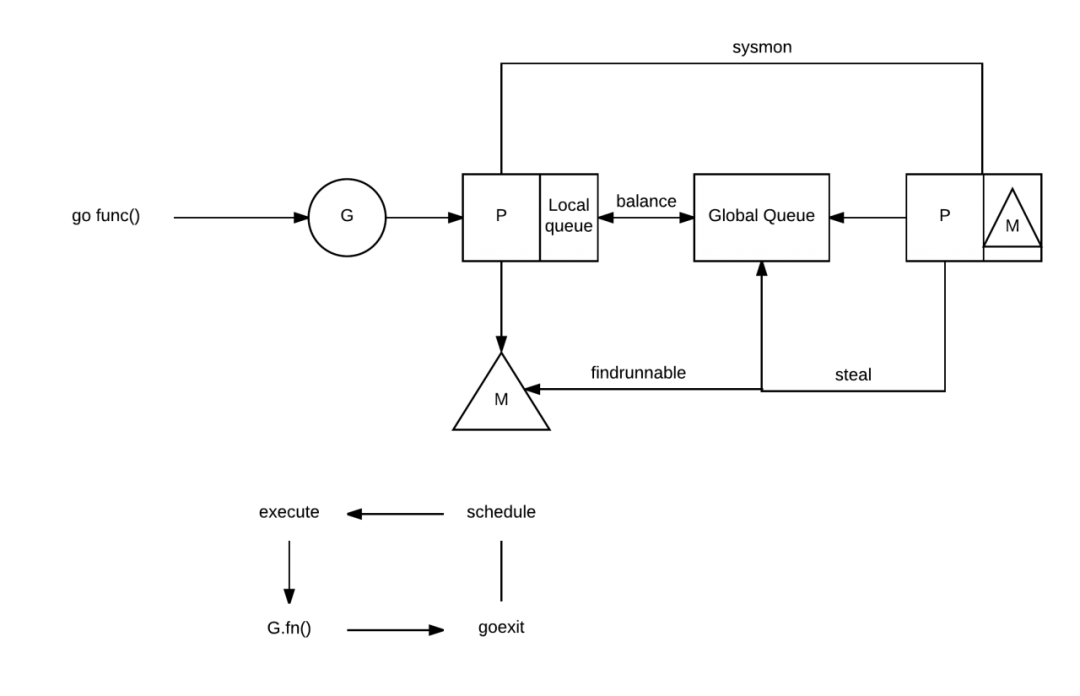 GPM 协作
GPM 协作
调度器的工作是将一个 G(需要执行的代码)、一个 M(代码执行的地方)和一个 P(代码执行所需要的权限和资源)结合起来。
所有的 g、m 和 p 对象都是分配在堆上且永不释放的,所以它们的内存使用是很稳定的。得益于此,runtime 可以在调度器实现中避免写屏障。当一个G执行完成后,可以放入pool中被再次使用,避免重复申请资源。
本节主要通过阅读runtime源码来认识这三个组件到底长的是什么样子,以此加深对 GPM 的理解。go version go1.15.6
理解下文前建议先阅读一下 src/runtime/HACKING.md 文件,中文可阅读 这里,这个文件内容是面向开发者理解runtime的很值得看一看。
本文若没有指定源码文件路径,则默认为 src/runtime/runtime2.go。
G
G是英文字母goroutine的缩写,一般称为“协程”,其实这个词还是无法完整表达它的意思的,但这用的人的多了就成了统称。注意它与线程和进程的区别,这个应该很容易理解,每个gopher应该都知道。
每个 Goroutine 对应一个 g 结构体,它有自己的栈内存, G 存储 Goroutine 的运行堆栈、状态以及任务函数,可重复用,
Goroutine数据结构位于 src/runtime/runtime2.go 文件,注意此文件里有太多重要的底层数据结构,对于我们理解底层runtime非常的重要,建议大量多看看。不需要记住每一个数据结构,但需要的时候要能第一时间想到在哪里查找。
当一个 goroutine 退出时,g 对象会被放到一个空闲的 g 对象池中以用于后续的 goroutine 的使用, 以减少内存分配开销。
Goroutine 字段非常的多,我们这里分段来理解
type g struct {
// Stack parameters.
// stack describes the actual stack memory: [stack.lo, stack.hi).
// stackguard0 is the stack pointer compared in the Go stack growth prologue.
// It is stack.lo+StackGuard normally, but can be StackPreempt to trigger a preemption.
// stackguard1 is the stack pointer compared in the C stack growth prologue.
// It is stack.lo+StackGuard on g0 and gsignal stacks.
// It is ~0 on other goroutine stacks, to trigger a call to morestackc (and crash).
stack stack // offset known to runtime/cgo
// 检查栈空间是否足够的值, 低于这个值会扩张栈, 0是go代码使用的
stackguard0 uintptr // offset known to liblink
// 检查栈空间是否足够的值, 低于这个值会扩张栈, 1是原生代码使用的
stackguard1 uintptr // offset known to liblink
}
stack 描述了当前 Goroutine 的栈内存范围[stack.lo, stack.hi),其中stack 的数据结构为
// Stack describes a Go execution stack.
// The bounds of the stack are exactly [lo, hi),
// with no implicit data structures on either side.
// 描述go执行栈
// 栈边界为[lo, hi),左包含可不包含,即 lo≤stack<hi
// 两边都没有隐含的数据结构。
type stack struct {
lo uintptr // 该协程拥有的栈低位
hi uintptr // 该协程拥有的栈高位
}
stackguard0 和 stackguard1 均是一个栈指针,用于扩容场景,前者用于 Go stack ,后者用于C stack。
如果 stackguard0 字段被设置成 StackPreempt 意味着当前 Goroutine 发出了抢占请求。
在g结构体中的stackguard0 字段是出现爆栈前的警戒线。stackguard0的偏移量是16个字节,与当前的真实SP(stack pointer)和爆栈警戒线(stack.lo+StackGuard)比较,如果超出警戒线则表示需要进行栈扩容.先调用runtime·morestack_noctxt()进行栈扩容,然后又跳回到函数的开始位置,此时此刻函数的栈已经调整了。然后再进行一次栈大小的检测,如果依然不足则继续扩容,直到栈足够大为止。对于StackGuard 的介绍可以参考 这里。
关于对 Stack 的理解可参考这篇 文章
type g struct {
preempt bool // preemption signal, duplicates stackguard0 = stackpreempt
preemptStop bool // transition to _Gpreempted on preemption; otherwise, just deschedule
preemptShrink bool // shrink stack at synchronous safe point
}
preempt 抢占标记,其值为true 执行 stackguard0 = stackpreempt
preemptStop 将抢占标记修改为 _Gpreedmpted,如果修改失败则取消
preemptShrink 在同步安全点收缩栈
type g struct {
_panic *_panic // innermost panic - offset known to liblink
_defer *_defer // innermost defer
}
_panic 当前Goroutine 中的panic
_defer 当前Goroutine 中的defer
type g struct {
m *m // current m; offset known to arm liblink
sched gobuf
goid int64
}
m 当前 Goroutine 绑定的M
sched 存储当前 Goroutine 调度相关的数据,上下方切换时会把当前信息保存到这里,用的时候再取出来,它的用途可参考函数 [newproc1()](https://github.com/golang/go/blob/go1.15.6/src/runtime/proc.go#L3566-L3674)。
goid 当前 Goroutine 的唯一标识,对开发者不可见,一般不使用此字段。可参考相关文章了解为什么Go开发团队为什么不向外开放访问此字段。
gobuf 结构体
type gobuf struct {
// The offsets of sp, pc, and g are known to (hard-coded in) libmach.
// 寄存器 sp,pc和g的偏移量,硬编码在libmach
//
// ctxt is unusual with respect to GC: it may be a
// heap-allocated funcval, so GC needs to track it, but it
// needs to be set and cleared from assembly, where it's
// difficult to have write barriers. However, ctxt is really a
// saved, live register, and we only ever exchange it between
// the real register and the gobuf. Hence, we treat it as a
// root during stack scanning, which means assembly that saves
// and restores it doesn't need write barriers. It's still
// typed as a pointer so that any other writes from Go get
// write barriers.
sp uintptr
pc uintptr
g guintptr
ctxt unsafe.Pointer
ret sys.Uintreg
lr uintptr
bp uintptr // for GOEXPERIMENT=framepointer
}
sp 栈指针位置
pc 程序计数器,运行到的程序位置
gobuf 主要存储一些寄存器信息,如sp、pc 和 g 的偏移量,硬编码在libmach
ctxt 不常见,可能是一个分配在heap的函数变量,因此GC 需要追踪它,不过它有可能需要设置并进行清除,在有写屏障 的时候有些困难。重点了解一下 write barriers
g 技能当前 gobuf 的 Goroutine
ret 系统调用的结果
bp 未知
调度器在将 G 由一种状态变更为另一种状态时,需要将上下文信息保存到这个gobuf结构体,当再次运行 G 的时候,再从这个结构体中读取出来,主要用来暂时上下文信息。其中的栈指针和程序计数器会用来存储或者恢复寄存器中的值,改变程序即将执行的代码。
Goroutine 的状态有以下几种( 源码)
| 状态 | 描述 |
|---|---|
_Gidle | 0 刚刚被分配并且还没有被初始化 |
_Grunnable | 1 没有执行代码,没有栈的所有权,存储在运行队列中 |
_Grunning | 2 可以执行代码,拥有栈的所有权,被赋予了内核线程 M 和处理器 P |
_Gsyscall | 3 正在执行系统调用,没有执行用户代码,拥有栈的所有权,被赋予了内核线程 M 但是不在运行队列上 |
_Gwaiting | 4 由于运行时而被阻塞,没有执行用户代码并且不在运行队列上,但是可能存在于 Channel 的等待队列上。若需要时执行ready()唤醒。 |
_Gmoribund_unused | 5 当前此状态未使用,但硬编码在了gdb 脚本里,可以不用关注 |
_Gdead | 6 没有被使用,可能刚刚退出,或在一个freelist;也或者刚刚被初始化;没有执行代码,可能有分配的栈也可能没有;G和分配的栈(如果已分配过栈)归刚刚退出G的M所有或从free list 中获取 |
_Genqueue_unused | 7 目前未使用,不用理会 |
_Gcopystack | 8 栈正在被拷贝,没有执行代码,不在运行队列上 |
_Gpreempted | 9 由于抢占而被阻塞,没有执行用户代码并且不在运行队列上,等待唤醒 |
_Gscan | 10 GC 正在扫描栈空间,没有执行代码,可以与其他状态同时存在 |
Goroutine 的状态
需要注意的是对于 _Gmoribund_unused 状态并未使用,但在 gdb 脚本中存在;而对于 _Genqueue_unused 状态目前也未使用,不需要关心。
_Gscan 与上面除了_Grunning 状态以外的其它状态相组合,表示 GC 正在扫描栈。Goroutine 不会执行用户代码,且栈由设置了 _Gscan 位的 Goroutine 所有。
| 状态 | 描述 |
|---|---|
_Gscanrunnable | = _Gscan + _Grunnable // 0x1001 |
_Gscanrunning | = _Gscan + _Grunning // 0x1002 |
_Gscansyscall | = _Gscan + _Gsyscall // 0x1003 |
_Gscanwaiting | = _Gscan + _Gwaiting // 0x1004 |
_Gscanpreempted | = _Gscan + _Gpreempted // 0x1009 |
Goroutine 的状态
可以看到除了上面提到的两个未使用的状态外一共有14种状态值。许多状态之间是可以进行改变的。如下图所示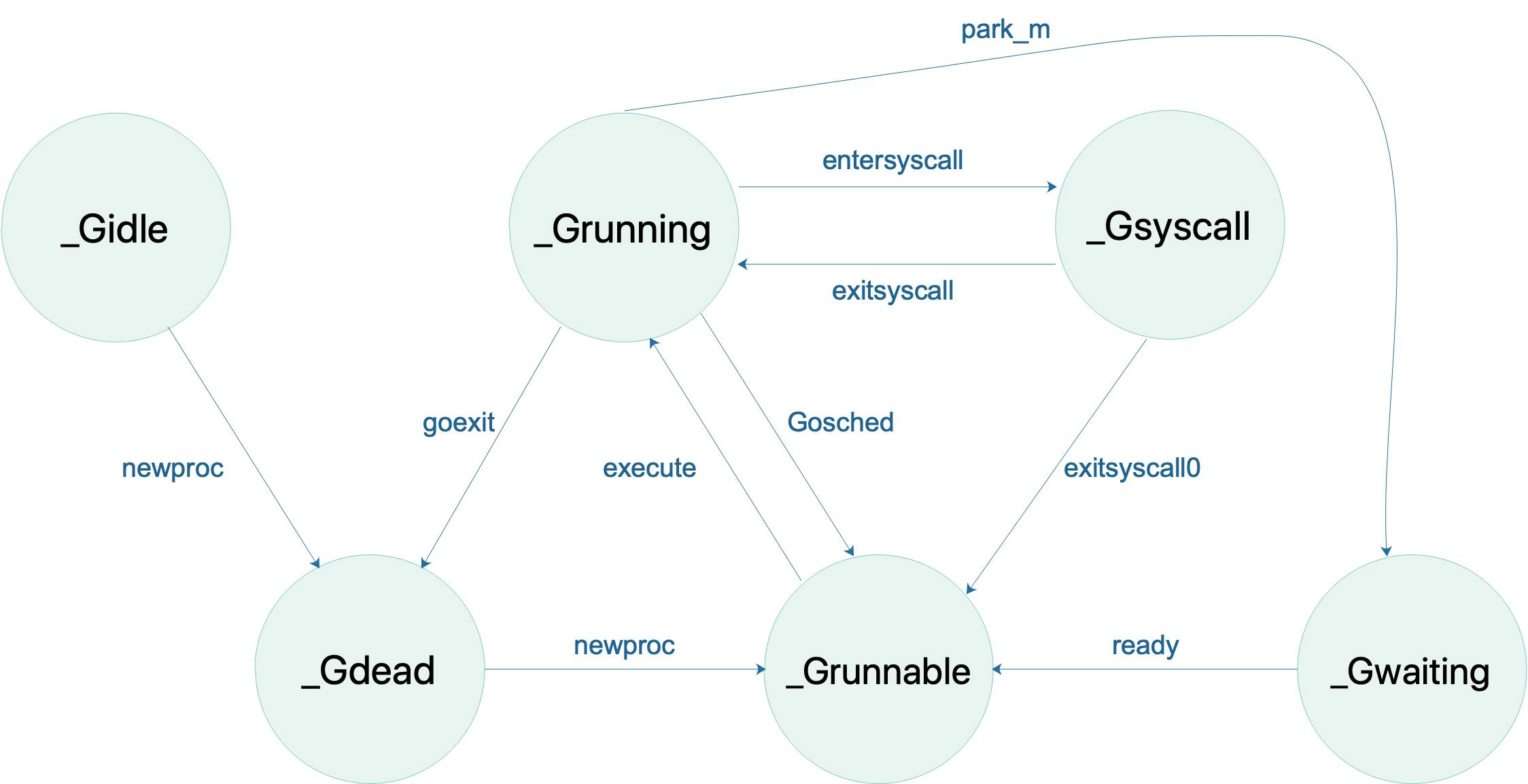 goroutine status ( https://github.com/golang-design/Go-Questions)
goroutine status ( https://github.com/golang-design/Go-Questions)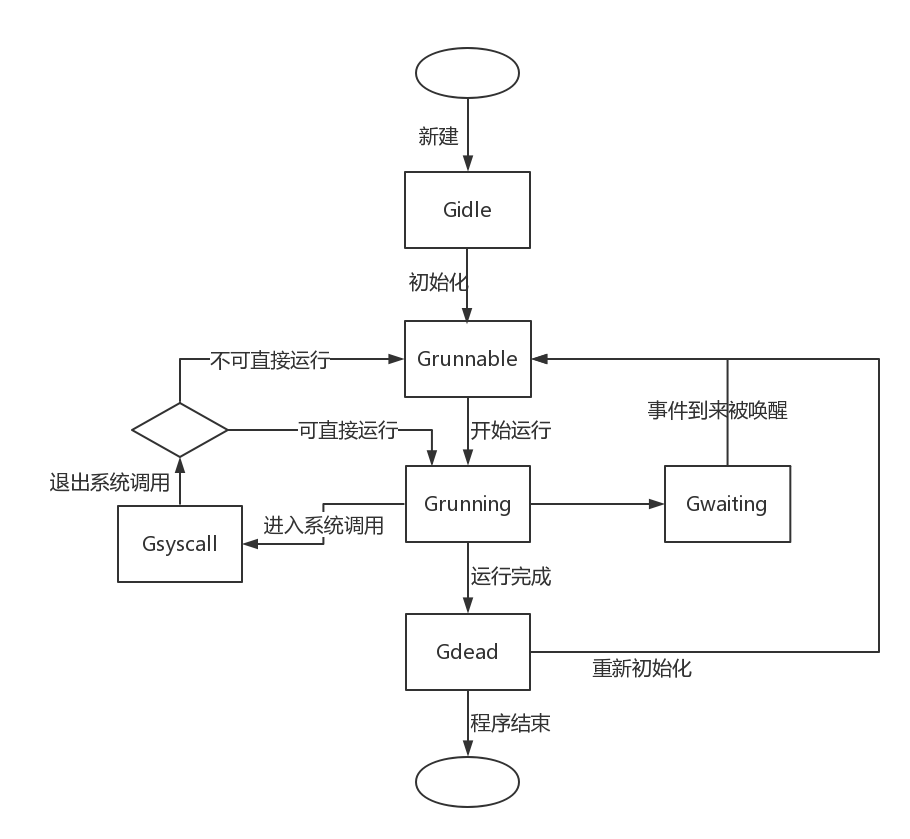 G的状态机流转图
G的状态机流转图
type g strcut {
syscallsp uintptr // if status==Gsyscall, syscallsp = sched.sp to use during gc
syscallpc uintptr // if status==Gsyscall, syscallpc = sched.pc to use during gc
stktopsp uintptr // expected sp at top of stack, to check in traceback
param unsafe.Pointer // passed parameter on wakeup
atomicstatus uint32
stackLock uint32 // sigprof/scang lock; TODO: fold in to atomicstatus
}
atomicstatus 当前G的状态,上面介绍过G的几种状态值
syscallsp 如果G 的状态为 Gsyscall ,那么值为 sched.sp 主要用于GC 期间
syscallpc 如果G的状态为 GSyscall ,那么值为 sched.pc 同上也是用于GC 期间,由此可见这两个字段是一起使用的
stktopsp 用于回源跟踪,如何理解?
param 唤醒G时传入的参数,如调用 ready()
stackLock 栈锁,什么场景下会使用?
type g struct {
waitsince int64 // approx time when the g become blocked
waitreason waitReason // if status==Gwaiting
}
waitsince G 阻塞时长
waitreason 阻塞原因
type g struct {
// asyncSafePoint is set if g is stopped at an asynchronous
// safe point. This means there are frames on the stack
// without precise pointer information.
asyncSafePoint bool
paniconfault bool // panic (instead of crash) on unexpected fault address
gcscandone bool // g has scanned stack; protected by _Gscan bit in status
throwsplit bool // must not split stack
}
asyncSafePoint 异步安全点;如果 g 在异步安全点停止则设置为true,表示在栈上没有精确的指针信息
paniconfault 地址异常引起的panic(代替了崩溃)
gcscandone g 扫描完了栈,受状态 _Gscan 位保护
throwsplit 不允许拆分stack 什么意思?
type g struct {
// activeStackChans indicates that there are unlocked channels
// pointing into this goroutine's stack. If true, stack
// copying needs to acquire channel locks to protect these
// areas of the stack.
activeStackChans bool
// parkingOnChan indicates that the goroutine is about to
// park on a chansend or chanrecv. Used to signal an unsafe point
// for stack shrinking. It's a boolean value, but is updated atomically.
parkingOnChan uint8
}
activeStackChans 表示是否有未加锁定的channel指向到了g 栈,如果为true,那么对栈的复制需要channal锁来保护这些区域
parkingOnChan 表示g 是放在chansend 还是 chanrecv。用于栈的收缩,是一个布尔值,原子更新
type g struct {
raceignore int8 // ignore race detection events
sysblocktraced bool // StartTrace has emitted EvGoInSyscall about this goroutine
sysexitticks int64 // cputicks when syscall has returned (for tracing)
traceseq uint64 // trace event sequencer
tracelastp puintptr // last P emitted an event for this goroutine
lockedm muintptr
sig uint32
writebuf []byte
sigcode0 uintptr
sigcode1 uintptr
sigpc uintptr
gopc uintptr // pc of go statement that created this goroutine
ancestors *[]ancestorInfo // ancestor information goroutine(s) that created this goroutine (only used if debug.tracebackancestors)
startpc uintptr // pc of goroutine function
racectx uintptr
waiting *sudog // sudog structures this g is waiting on (that have a valid elem ptr); in lock order
cgoCtxt []uintptr // cgo traceback context
labels unsafe.Pointer // profiler labels
timer *timer // cached timer for time.Sleep
selectDone uint32 // are we participating in a select and did someone win the race?
}
gopc 创建当前G的pc
startpc go func 的pc
waiting 如何理解?
timer 通过time.Sleep 缓存 timer
从字段命名来看,许多字段都与trace 有关,不清楚什么意思
type g struct {
// Per-G GC state
// gcAssistBytes is this G's GC assist credit in terms of
// bytes allocated. If this is positive, then the G has credit
// to allocate gcAssistBytes bytes without assisting. If this
// is negative, then the G must correct this by performing
// scan work. We track this in bytes to make it fast to update
// and check for debt in the malloc hot path. The assist ratio
// determines how this corresponds to scan work debt.
gcAssistBytes int64
}
gcAssistBytes 与GC相关。
为了保证用户程序分配内存的速度不会超出后台任务的标记速度,运行时还引入了标记辅助技术,它遵循一条非常简单并且朴实的原则,分配多少内存就需要完成多少标记任务。每一个 Goroutine 都持有 gcAssistBytes 字段,这个字段存储了当前 Goroutine 辅助标记的对象字节数。在并发标记阶段期间,当 Goroutine 调用 runtime.mallocgc 分配新对象时,该函数会检查申请内存的 Goroutine 是否处于入不敷出的状态。
总结
- 每个 G 都有自己的状态,状态保存在
atomicstatus字段,共有十几种状态值。 - 每个 G 在状态发生变化时,即
atomicstatus字段值被改变时,都需要保存当前G的上下文的信息,这个信息存储在sched字段,其数据类型为gobuf,想理解存储的信息可以看一下这个结构体的各个字段 - 每个 G 都有三个与抢占有关的字段,分别为
preempt、preemptStop和premptShrink - 每个 G 都有自己的唯一id, 字段为
goid,但此字段官方不推荐开发使用 - 每个 G 最多可以绑定一个
m,如果未绑定,则值为nil - 每个 G 都有自己内部的
defer和panic。 - G 可以被阻塞,并存储有阻塞原因,字段
waitsince和waitreason - G 可以被进行 GC 扫描,相关字段为
gcscandone、atomicstatus(_Gscan与上面除了_Grunning状态以外的其它状态组合)
P
P 表示逻辑处理器,对 G 来说,P 相当于 CPU 核,G 只有绑定到 P 才能被调度。对 M 来说,P 提供了相关的执行环境(Context),如内存分配状态(mcache),任务队列(G)等。
P 的数量决定了系统内最大可并行的 G 的数量(前提:逻辑 CPU 核数 >= P 的数量)。推荐使用默认值,过多的设置P的个数可能会导致上下文的切换成本。
另外在容器应用里,P 的默认值是读取的 /proc/cpuinfo 文件,因此如果在启动容器时指定了cpu个数,则会导致实现P的个数>逻辑cpu个数,这样容易产生上下方切换成本过高问题,此时建议在程序中使用三方库,如 https://github.com/uber-go/automaxprocs 来解决此类问题。
P的数据结构也有几十个字段,我们将其分开来理解
type p struct {
id int32
status uint32 // one of pidle/prunning/...
link puintptr
schedtick uint32 // incremented on every scheduler call
syscalltick uint32 // incremented on every system call
sysmontick sysmontick // last tick observed by sysmon
}
id: P的唯一标识
status P当前状态,状态值有_Pidle、_Prunning、_Psyscall、_Pgcstop 和 _Pdead
link 未知
schedtick 每当被调度时递增
syscalltick 每当系统调用时递增
sysmontick sysmon 最后tick的时间,是一个 [sysmontick](https://github.com/golang/go/blob/go1.15.6/src/runtime/proc.go#L4762) 数据类型。sysmon介绍: https://www.jianshu.com/p/469d0c7a7936
对于P的状态有五种:
| 状态 | 描述 |
|---|---|
_Pidle | 处理器没有运行用户代码或者调度器,被空闲队列或者改变其状态的结构持有,运行队列为空;也有可能是几种状态正在过度中状态 |
_Prunning | 被线程 M 持有,并且正在执行用户代码或者调度器。只能由拥有当前P的M才可能修改此状态。M可以将P的状态修改为_Pidle(无工作可做)、_Psyscall(系统调用) 或 _Pgstop(GC); 另外M也可以P的使用权交给另一个M(调度一个锁定状态的G) |
_Psyscall | 当前P没有执行用户代码,当前线程陷入系统调用 |
_Pgcstop | 被线程 M 持有,当前处理器由于垃圾回收被停止,由 _Prunning 变为 _Pgcstop |
_Pdead | 当前处理器已经不被使用,如通过动态调小 GOMAXPROCS 进行 P 收缩 |
P 的状态
type p struct {
m muintptr // back-link to associated m (nil if idle)
mcache *mcache
pcache pageCache
raceprocctx uintptr
}
m 当前正在绑定的m, 有可能为空,如_Pidle
mcache 每个p的小对象缓存,无锁,对应 [mcache](https://github.com/golang/go/blob/go1.15.6/src/runtime/mcache.go#L19-L54) 结构体
pcache 页面缓存,对应 [pageCache](https://github.com/golang/go/blob/go1.15.6/src/runtime/mpagecache.go#L14-L99) 结构体,不需要锁
raceprocctx race相关
其中 mcache 和 pcache 全是缓存相关字段,两个都是无锁结构体。
mcache是为了当G与P关联后,执行go code时,会为一些小对象(<32K)分配内存,这时直接从P.mcache 申请,避免直接从os申请,这样就允许多个P并发执行,减少申请内存的锁粒度,参考 这里。
type p struct {
deferpool [5][]*_defer // pool of available defer structs of different sizes (see panic.go)
deferpoolbuf [5][32]*_defer
}
deferpool 不同大小的defer,二维数组。具体见 panic.go 文件,有对此字段的一些处理逻辑
deferpoolbuf 同上
这两个字段是与 defer 相关
type p struct {
// Cache of goroutine ids, amortizes accesses to runtime·sched.goidgen.
goidcache uint64
goidcacheend uint64
}
goidcache goid 缓存
goidcacheend goid 缓存
两个都是 goroutine ids 的缓存。
type p struct {
// Queue of runnable goroutines. Accessed without lock.
runqhead uint32
runqtail uint32
runq [256]guintptr
// runnext, if non-nil, is a runnable G that was ready'd by
// the current G and should be run next instead of what's in
// runq if there's time remaining in the running G's time
// slice. It will inherit the time left in the current time
// slice. If a set of goroutines is locked in a
// communicate-and-wait pattern, this schedules that set as a
// unit and eliminates the (potentially large) scheduling
// latency that otherwise arises from adding the ready'd
// goroutines to the end of the run queue.
runnext guintptr
}
runqhead 运行队列头
runqtail 运行队列尾
runq 运行队列, 数组类型,最大值为256
每个P都有一个自己的runq,除了自身有的runq 还有一个全局的runq, 对于每个了解过GPM的gohper应该都知道这一点。每个P下面runq的允许的最大goroutine 数量为256。
runnext 当前P(进入运行状态时)立即要运行的goroutine,可能为nil。如果此字段不为nil 的话,则表示下次即将运行的 goroutine,将直接从 runnext 字段取,而不必从 runq 中获取,因此其优先级高于runq。如果当前G 还有剩余的可用时间,那么就运行这个 runnext 的G 继承剩下的时间。此字段的调用请参考函数 runtime.runqget()。
这个字段是用来实现调度器亲和性的,我们知道原来一个G阻塞时,这时P会再获取一个G进行绑定执行,如果这时原来的G执行阻塞结束后,如果想再次被接着继续执行,就需要重新在P的 runq 进行排队,当 runq 里有太多的goroutine 时将会导致这个刚刚被解除阻塞的G迟迟无法得到执行,同时还有可能被其他处理器所窃取。从 Go 1.5 开始得益于 P 的特殊属性,从阻塞 channel 返回的 Goroutine 会优先运行,这里只需要将这个G放在 runnext 这个字段即可。参考文章 理解 Go 并发以及调度器亲和性
上面介绍了每个 P 的runq最大可以有256个goroutine, 再加上这个 runnext 字段的话,一个P最大的情况下可以有257个goroutine了。
type p struct {
// Available G's (status == Gdead)
gFree struct {
gList
n int32
}
}
gFree 结构体表示空闲G的信息, 而其中 gFree.n 表示空闲G的个数。此结构体主要是为了方便实现对G的复用(只有当状态为 Gdead 时才有效)。关注一下 匿名结构体内的 [gList](https://github.com/golang/go/blob/go1.15.6/src/runtime/proc.go#L5435-L5467) 字段, 这个字段在上篇 文章《Golang中channel实现原理源码分析》 里也介绍过它的使用场景。
type p struct {
sudogcache []*sudog
sudogbuf [128]*sudog
}
sudogcache 缓存相关,slice 类型,*sudog 数据结构
sudogbuf 数组类型,*sudog 缓冲区
与*sudog 相关,可以看出与goroutine相关。不清楚这两个字段与上面的 runq 作用是什么。
type p strcut {
// Cache of mspan objects from the heap.
mspancache struct {
// We need an explicit length here because this field is used
// in allocation codepaths where write barriers are not allowed,
// and eliminating the write barrier/keeping it eliminated from
// slice updates is tricky, moreso than just managing the length
// ourselves.
len int
buf [128]*mspan
}
}
mspancache 从堆中缓存mspan对象。mspan是什么?
type p struct {
tracebuf traceBufPtr
// traceSweep indicates the sweep events should be traced.
// This is used to defer the sweep start event until a span
// has actually been swept.
traceSweep bool
// traceSwept and traceReclaimed track the number of bytes
// swept and reclaimed by sweeping in the current sweep loop.
traceSwept, traceReclaimed uintptr
}
与trace相关
type p struct {
palloc persistentAlloc // per-P to avoid mutex
_ uint32 // Alignment for atomic fields below
// The when field of the first entry on the timer heap.
// This is updated using atomic functions.
// This is 0 if the timer heap is empty.
timer0When uint64
}
palloc ???
_ 为了下面字段原子操作而进行的内存对齐填充
timer0When 此字段由原子操作函数执行,如果 timer heap 为空,则值为 0。它表示P的 timer 定时器小堆第一个对象的when字段值,即最先执行的时间值
type p struct {
// Per-P GC state
gcAssistTime int64 // Nanoseconds in assistAlloc
gcFractionalMarkTime int64 // Nanoseconds in fractional mark worker (atomic)
gcBgMarkWorker guintptr // (atomic)
gcMarkWorkerMode gcMarkWorkerMode
// gcMarkWorkerStartTime is the nanotime() at which this mark
// worker started.
gcMarkWorkerStartTime int64
// gcw is this P's GC work buffer cache. The work buffer is
// filled by write barriers, drained by mutator assists, and
// disposed on certain GC state transitions.
gcw gcWork
// wbBuf is this P's GC write barrier buffer.
//
// TODO: Consider caching this in the running G.
wbBuf wbBuf
runSafePointFn uint32 // if 1, run sched.safePointFn at next safe point
}
P 的 GC 状态
gcMarkWrokderStartTime gc的开始时间
gcw GC work的 buffer, 写屏障填充,结构体 gcWork
wbBuf P的GC写屏障buffer
runSafePointFn 如果为1,则在下一个安全点运行 sched.safePointFn
各种状态的切换图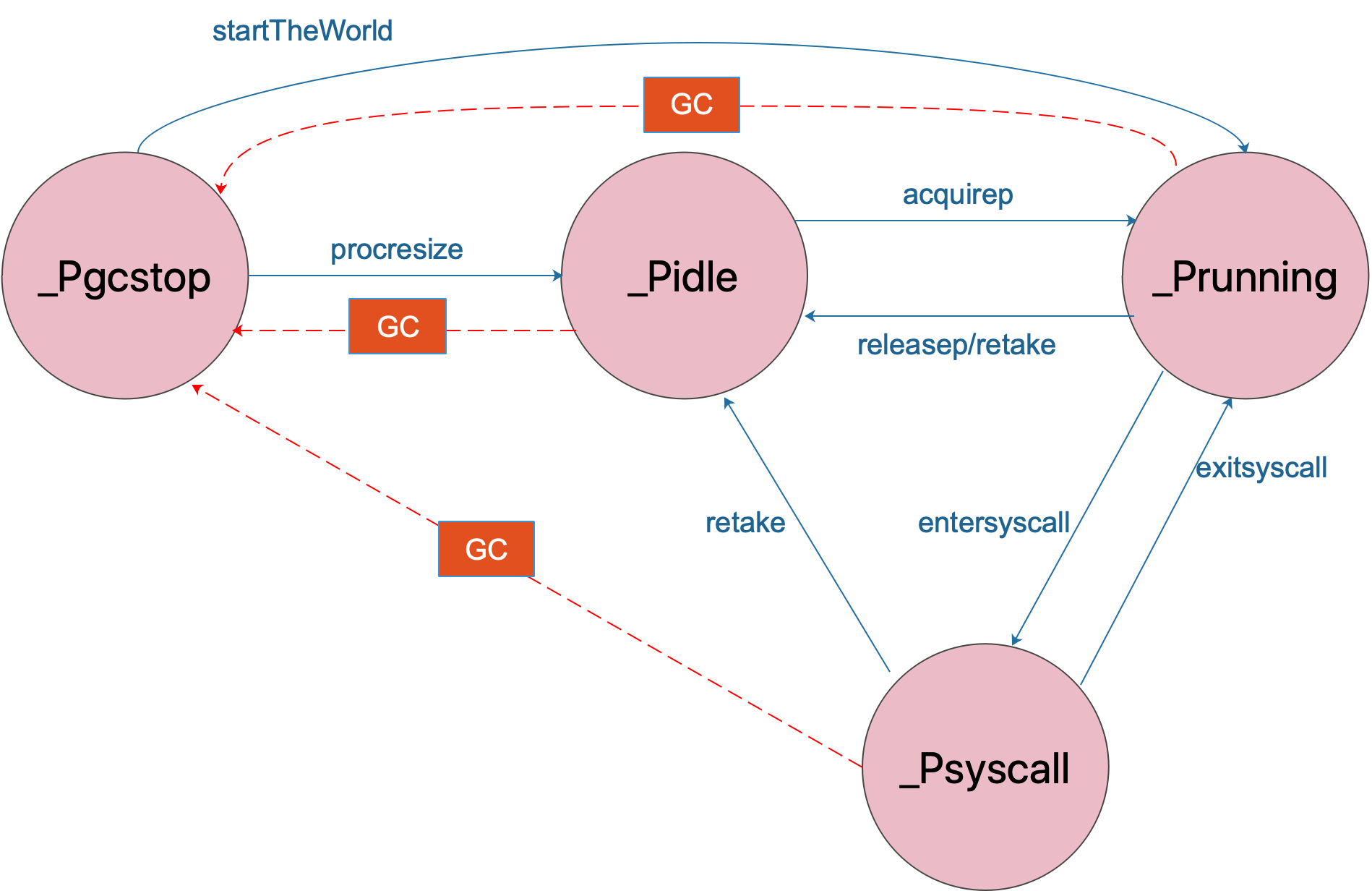 p status ( https://github.com/golang-design/Go-Questions)
p status ( https://github.com/golang-design/Go-Questions)
type p strcut {
// Lock for timers. We normally access the timers while running
// on this P, but the scheduler can also do it from a different P.
timersLock mutex
// Actions to take at some time. This is used to implement the
// standard library's time package.
// Must hold timersLock to access.
timers []*timer
// Number of timers in P's heap.
// Modified using atomic instructions.
numTimers uint32
// Number of timerModifiedEarlier timers on P's heap.
// This should only be modified while holding timersLock,
// or while the timer status is in a transient state
// such as timerModifying.
adjustTimers uint32
// Number of timerDeleted timers in P's heap.
// Modified using atomic instructions.
deletedTimers uint32
// Race context used while executing timer functions.
timerRaceCtx uintptr
}
timerLock timer锁
timers timer指针切片类型,timer 是标准库结构
numTimers P堆中的timer数,原子指令修改
adjustTimers p堆中 timerModifiedEarlier timer 的数量,修改时必须持有timerLock锁, 或者当定时器状态处于瞬态时,例如定时器调整。
deletedTimers 当前中p 堆中的 deletedTimers 计数器数量,原子指令修改
timerRaceCtx 执行计时器函数时使用的竞争上下文
上方 timer0When、timerModifiedEarliest、timersLock、timers、numTimers、adjustTimers、deletedTimers 、timerDeleted 和 timerModifiedEarlier,与其它几个相关的 timer 字段均与定时器有关。
type p struct {
// preempt is set to indicate that this P should be enter the
// scheduler ASAP (regardless of what G is running on it).
preempt bool
pad cpu.CacheLinePad
}
preempt 抢占标记,如果值为true,表示 p 进入调度(不管G在运行什么),关于抢占可以参考 《Golang 基于信号的异步抢占与处理》
pad cache line 对齐优化。不了解可参考文章 CPU缓存体系对Go程序的影响
总结
- 每个P都有自己的状态,分别为
_Pidle、_Prunning、_Psyscall、_Pgcstop、_Pdead - 每个P都存储有自己被
调度次数和系统调用的次数,字段schedtick和syscalltick - P 可以绑定一个M。但也可以不绑定,这时m值为
nil,字段m - 每个P 都有一个自己的
runq,用来存放可以runnable状态的 goroutines, 最多可以存放256个 goroutine。一般在介绍GMP关系时,我们称之为 local queue 或 LRQ,当然还有一个global queue, 有时候也简写成 GRQ - 每个P都可能有一个
runnext的 goroutine。如果此字段不为nil,则P下次执行G的时候,优先执行此字段的goroutine - P可以缓存goroutine,字段
goidcache - P的GC状态
- P可以有多个timer, 以slice 形式存储, 字段
timers - P可以缓存堆上面的
mspan对象,mspan对象是什么? - P 有一个抢占标记,字段为
preempt。如果为ture ,则表示P立即进入调度 - P结构体使用了pad, 以优化cpu, 解决 cpu伪共享 的问题
M
M 是指OS 内核线程,代表着真正执行计算的资源,在绑定有效的 P 后,进入 schedule 循环;而 schedule 循环的机制大致是从 Global 队列、P 的 Local 队列以及 wait 队列中获取。
M 在runtime中对应的是 m 结构体。
**M 的数量是不定的,由 Go Runtime 调整,**为了防止创建过多 OS 线程导致系统调度不过来,目前默认最大限制为 10000 个。如果一个M工作完成后,找不到可用的P,则需要将自己休眠,并放在空闲线程中,等待下次使用。
切记:M 并不保留 G 状态,这是 G 可以跨 M 调度的基础。
下面对 m 的结构体做下介绍
type m struct {
g0 *g // goroutine with scheduling stack
morebuf gobuf // gobuf arg to morestack
divmod uint32 // div/mod denominator for arm - known to liblink
}
g0 这是一个很特殊的goroutine, 它是一个具有调度堆栈的能力, 参考 这里 、 这里 或 这里
morebuf 堆栈扩容使用(见这里),gobuf 数据类型,gobuf这个数据结构在g结构体中已出现过,它的作用就是保存一个g 的上下文数据。这里作为传递给 morestack 的参数
divmod 未知?
type m struct {
// Fields not known to debuggers.
procid uint64 // for debuggers, but offset not hard-coded
gsignal *g // signal-handling g
goSigStack gsignalStack // Go-allocated signal handling stack
sigmask sigset // storage for saved signal mask
tls [6]uintptr // thread-local storage (for x86 extern register)
mstartfn func()
curg *g // current running goroutine
caughtsig guintptr // goroutine running during fatal signal
p puintptr // attached p for executing go code (nil if not executing go code)
nextp puintptr
oldp puintptr // the p that was attached before executing a syscall
id int64
}
procid 调度器使用,非硬编码的偏移量, 可以向这个pid发送 signal,参考 https://blog.haohtml.com/archives/23854
gsignal 信号堆栈 gsignal stack ,作用见这里
goSigStack 分配的信号处理栈,数据类型为 [gsignalStack](https://github.com/golang/go/blob/go1.15.6/src/runtime/signal_unix.go#L1168-L1173)
sigmask 存储的信号掩码,数据类型为 sigset,作用是?
tls 数组类型,本地线程存储,最多为6个
mstartfn 表示m启动时立即执行的函数,对其的调用见 [mstart1()](https://github.com/golang/go/blob/go1.15.6/src/runtime/proc.go#L1150-L1180)
curg 当前正在运行的 goroutine
caughtsig 在致命信号期间运行的goroutine
p 用于执行go code 的 p,就是当前正在m绑定的P,如果没有运行code 的话,值为nil
nextp 下次运行时的P
oldp 在执行系统调用之前绑定的P, 见 reentersyscall() 和 exitsyscall() 函数
id m的唯一id
其中与goroutine有关的字段有caughtsig 和 curg,其中 curg 这个就是当前m绑定的goroutine;
gsignal stack 的解释
在Golang的runtime包中,gsignal stack(信号堆栈)是用来处理操作系统信号的栈空间。当操作系统发送信号给Go程序时,信号处理函数会在gsignal stack上运行。这个栈是独立于普通的goroutine栈的,用于专门处理信号的相关操作。
gsignal stack的主要作用是提供一个独立的执行环境,确保信号处理函数能够正常运行而不受其他goroutine的影响。在处理信号期间,runtime会禁止抢占和栈扩展,以确保信号处理函数的运行不会被干扰。
由于信号处理函数需要尽可能地简洁和高效,gsignal stack的大小是固定的,并且相对较小。这是因为在信号处理期间,只能执行少量的操作,例如发送或接收信号、终止程序等。过多的操作可能会带来不可预知的问题。
需要注意的是,gsignal stack不同于goroutine栈,它是专门用于处理信号的,而goroutine栈则用于正常的程序执行。这样的设计可以有效地隔离信号处理函数和普通程序逻辑,提高信号处理的可靠性和安全性。
与p相关的字段 p、nextp、oldp,分别表示 当前绑定的P、下次绑定的P 和 上次绑定的P,这几个字段均在 /runtime/proc.go 文件中使用。
type m struct {
mallocing int32
throwing int32
preemptoff string // if != "", keep curg running on this m
locks int32
dying int32
profilehz int32
}
throwing 当前m抛出异常,即调用了内部函数 throw
preemptoff 如果非空,则保持curg 运行在当前m。
其它几个字段未知
type m struct {
spinning bool // m is out of work and is actively looking for work
blocked bool // m is blocked on a note
newSigstack bool // minit on C thread called sigaltstack
printlock int8
incgo bool // m is executing a cgo call
freeWait uint32 // if == 0, safe to free g0 and delete m (atomic)
fastrand [2]uint32
needextram bool
traceback uint8
}
spinning 表示当前m空闲,需要找一个新的工作来执行
blocked 在 note 阻塞
newSigstack 在一个C 线程被调用 sigaltstack
printlock ?
incgo 当前m正在执行一个cgo调用
freeWait 如果值为0,则需要安全的释放go并删除m(原子操作)
fastrand ?
needextram ?
traceback trace 相关
对于 spinning 这个情况经常见,当前m没有活干了,需要努力找一个新活干,属于GMP调度中的一个关系点。
note 的数据结构为
// sleep and wakeup on one-time events.
// before any calls to notesleep or notewakeup,
// must call noteclear to initialize the Note.
// then, exactly one thread can call notesleep
// and exactly one thread can call notewakeup (once).
// once notewakeup has been called, the notesleep
// will return. future notesleep will return immediately.
// subsequent noteclear must be called only after
// previous notesleep has returned, e.g. it's disallowed
// to call noteclear straight after notewakeup.
// 一次性事件中的休眠和唤醒
// 对于任何调用 notesleep 或 notwakeup 之前,必须调用 noteclear 进行初始化操作。
// 那么,一个线程调用 notesleep, 一个线程调用 notewakup(只能一次)。
// 当 notewakeup 被调用后,notesleep 还未返回,需要过一段时间 notesleep 才能调用完成。在继续调用 noteclear 之前,必须等待当前一个 notesleep 返回后才可以,
// 不允许在 notewakeup 后直接调用 noteclear。
//
// notetsleep is like notesleep but wakes up after
// a given number of nanoseconds even if the event
// has not yet happened. if a goroutine uses notetsleep to
// wake up early, it must wait to call noteclear until it
// can be sure that no other goroutine is calling
// notewakeup.
// notetsleep 类似 notesleep, 但唤醒后会返回一个纳秒数值(如果事件正好还不没有发生)
// 如果一个 goroutine 提前使用了 notetsleep 唤醒,它必须等待调用完 noteclear,直到确认没有其它goroutine调用 notewakeup
//
// notesleep/notetsleep are generally called on g0,
// notetsleepg is similar to notetsleep but is called on user g.
// notesleep/notetsleep 通常在 g0 上调用, notetsleepg类似于notetsleep,但在用户g上调用(可能指的用户态的G)
type note struct {
// Futex-based impl treats it as uint32 key,
// while sema-based impl as M* waitm.
// Used to be a union, but unions break precise GC.
key uintptr
}
对于 note 这个类型,在调度时经常使用,就有三个与其相关的命令(notesleep、notewakup 和 noteclear, 注意这们的调用顺序要求),参考: https://www.purewhite.io/2019/11/28/runtime-hacking-translate/#%E5%90%8C%E6%AD%A5。
type m struct {
ncgocall uint64 // number of cgo calls in total
ncgo int32 // number of cgo calls currently in progress
cgoCallersUse uint32 // if non-zero, cgoCallers in use temporarily
cgoCallers *cgoCallers // cgo traceback if crashing in cgo call
}
ncgocall cgo的总调用次数
ncgo 目前正在执行的cgo调用数
cgoCallersUse 如果 > 0,临时使用cgoCallers
cgoCaller 如果在调用 cgo 时奔溃,则是进行回溯?
这四个字段主要与cgo相关。
type m struct {
park note
alllink *m // on allm
schedlink muintptr
lockedg guintptr
createstack [32]uintptr // stack that created this thread.
lockedExt uint32 // tracking for external LockOSThread
lockedInt uint32 // tracking for internal lockOSThread
nextwaitm muintptr // next m waiting for lock
}
park 数据类型为 note , M休眠时使用的信号量, 唤醒M时会通过它唤醒
alllink ?
schedlink 调度相关,下一个m, 当m在链表结构中会使用
lockedg 锁定的goroutine, g.lockedm的对应值
createstatck 创建当前线程的栈
lockedExt 跟踪外部锁线程
lockedInt 跟踪内部锁线程
nextwaitm 下一个等待此锁的m
type m struct {
waitunlockf func(*g, unsafe.Pointer) bool
waitlock unsafe.Pointer
waittraceev byte
waittraceskip int
startingtrace bool
syscalltick uint32
freelink *m // on sched.freem
}
waitunlockf 等待解锁函数
waitlock 等待锁
waittraceev
waittraceskip
startingtrace
syscalltick
freelink m释放列表,链接到 sched.freem 字段
对于 waitlockf、 waitlock 、waittraceev、waittraceskip 是与调度相关有关的字段(见 gppark() 函数)。startingtrace 是与trace相关的三个字段。freelink 看注释是与调度有关的。
type m strcut {
// these are here because they are too large to be on the stack
// of low-level NOSPLIT functions.
libcall libcall
libcallpc uintptr // for cpu profiler
libcallsp uintptr
libcallg guintptr
syscall libcall // stores syscall parameters on windows
vdsoSP uintptr // SP for traceback while in VDSO call (0 if not in call)
vdsoPC uintptr // PC for traceback while in VDSO call
}
前五个字段可能与库调用相关,它们之所以出现在这里,是因为它们太大了,不可能出现在低级NOSPLIT函数的堆栈中。
vdsoSP 和 vdsoPC 属于VDSO调用。vdsoSP 如果值为0,则表示没有调用。
type m struct {
// preemptGen counts the number of completed preemption
// signals. This is used to detect when a preemption is
// requested, but fails. Accessed atomically.
preemptGen uint32
// Whether this is a pending preemption signal on this M.
// Accessed atomically.
signalPending uint32
dlogPerM
mOS
// Up to 10 locks held by this m, maintained by the lock ranking code.
locksHeldLen int
locksHeld [10]heldLockInfo
}
preemptGen完成的抢占信号数量。这用于检测何时请求抢占,但是失败了。原子访问
signalPending 是不是当前M上挂起的抢占信号
dlogPerM ?
mOS ?
locksHeldLen 当前持有锁的数量
locksHeld 最多可以持有1个锁,数据类型为 heldLockInfo,
preemptGen 和 signalPending 是与抢占有关的字段;
locksHeldLen 和 locksHeld 是表示持有锁的信息,他们由ranking code 维护。
对于 heldLockInfo 数据结构
// heldLockInfo gives info on a held lock and the rank of that lock
// heldLockInfo 提供了一个锁的相关信息和锁的等级
type heldLockInfo struct {
lockAddr uintptr
rank lockRank
}
// src/runtime/lockrank.go
type lockRank int
总结
- 每个 m 都持有一个特殊的goroutine,我们称之为g0,它具有调度栈的能力。调度和执行系统调用时会先切换到这个g
- m 可以与一个G相绑定,字段
curg - m 可以与P绑定,也可以不绑定,如果已绑定则字段p不非
nil - m 可以记录下次和上次绑定的p,字段
nextp和oldp - 如果m 没有工作可做的话,它会通过自旋积极再找一个活干
- m会不会在
note阻塞 - 可以记录对m完成抢占信息的次数
- 一个m最多可以持有10个锁
Sched
上面我们分别介绍了 G/P/M 三者的数据结构,想必对他们结构体中的每个字段的作用有了一点的了解了,然而三者的协作需要一个负责协调的角色,而这正是 go sched 的职责。
**Go 调度器,**它维护有存储 M 和 G 的队列以及调度器的一些状态信息等,全局调度时使用。
调度器循环的机制大致是从各种队列、P 的本地队列中获取 G,然后切换到 G 的执行栈上并执行 G 的函数,调用 Goexit 做清理工作并回到 M,如此反复。
对于三者调度逻辑可参考文章 Go netpoller 网络模型之源码全面解析
下面我们再看一下它的数据结构
type schedt struct {
// accessed atomically. keep at top to ensure alignment on 32-bit systems.
// 原子访问, 最顶部,保证32位系统下的对齐
goidgen uint64
// 上次网络轮询的时间,如果当前正在轮询,则为0
lastpoll uint64 // time of last network poll, 0 if currently polling
// 当前轮询休眠的时间
pollUntil uint64 // time to which current poll is sleeping
lock mutex
// When increasing nmidle, nmidlelocked, nmsys, or nmfreed, be
// sure to call checkdead().
// 当增加 nmidle,nmidlelocked, nmsys或 nmfreed 的时候,一定要调用 checkdead()
// 空闲m等待队列
midle muintptr // idle m's waiting for work
// 空闲m的数量
nmidle int32 // number of idle m's waiting for work
// 等待工作的锁定m的数量
nmidlelocked int32 // number of locked m's waiting for work
// 已创建的m数和下一个m ID, 一个字段代表两个意义?
mnext int64 // number of m's that have been created and next M ID
// 允许的最大m数
maxmcount int32 // maximum number of m's allowed (or die)
// 死锁不计算系统m的数量
nmsys int32 // number of system m's not counted for deadlock
// 累计已释放m的数量
nmfreed int64 // cumulative number of freed m's
// 系统goroutins的数量,原子更新
ngsys uint32 // number of system goroutines; updated atomically
// 空闲p
pidle puintptr // idle p's
npidle uint32
// 自旋, 查看proc.go 文件的 "Worker thread parking/unparking" 注释
nmspinning uint32 // See "Worker thread parking/unparking" comment in proc.go.
// Global runnable queue.
// 全局运行队列信息, gQueue 是一个通过 g.schedlink 链接的双向队列
runq gQueue
// 队列大小
runqsize int32
// disable controls selective disabling of the scheduler.
//
// Use schedEnableUser to control this.
//
// disable is protected by sched.lock.
disable struct {
// user disables scheduling of user goroutines.
user bool
runnable gQueue // pending runnable Gs
n int32 // length of runnable
}
// Global cache of dead G's.
gFree struct {
lock mutex
stack gList // Gs with stacks
noStack gList // Gs without stacks
n int32
}
// Central cache of sudog structs.
sudoglock mutex
sudogcache *sudog
// Central pool of available defer structs of different sizes.
deferlock mutex
deferpool [5]*_defer
// freem is the list of m's waiting to be freed when their
// m.exited is set. Linked through m.freelink.
// freem 是当 他们的 m.exited 被设置时的等待被释放m列表,通过 m.freelink 链接
freem *m
// gc正在等待运行
gcwaiting uint32 // gc is waiting to run
stopwait int32
stopnote note
sysmonwait uint32
sysmonnote note
// safepointFn should be called on each P at the next GC
// safepoint if p.runSafePointFn is set.
// 如果 p.runSafePointFn 设置的话, safeopintFn 将在每个p下次 GC safepoint 时被调用
safePointFn func(*p)
safePointWait int32
safePointNote note
profilehz int32 // cpu profiling rate
// 对gomaxprocs的最后更改时间
procresizetime int64 // nanotime() of last change to gomaxprocs
totaltime int64 // ∫gomaxprocs dt up to procresizetime
// sysmonlock protects sysmon's actions on the runtime.
//
// Acquire and hold this mutex to block sysmon from interacting
// with the rest of the runtime.
// 在运行时,sysmonlock保护 sysmon 的运行
sysmonlock mutex
}
type schedt struct {
// accessed atomically. keep at top to ensure alignment on 32-bit systems.
// 原子访问, 最顶部位置,保证32位系统下的对齐
goidgen uint64
// 上次网络轮询的时间,如果当前正在轮询,则为0
lastpoll uint64 // time of last network poll, 0 if currently polling
// 当前轮询休眠的时间
pollUntil uint64 // time to which current poll is sleeping
lock mutex
}
goidgen 目前还不清楚它的作用
lastpoll 上次网络轮询的时间,如果值为0,表示当前正在轮询
pollUntil 当前由于轮询导致的休眠的时间
lock 锁
type schedt struct {
// When increasing nmidle, nmidlelocked, nmsys, or nmfreed, be
// sure to call checkdead().
// 当增加 nmidle,nmidlelocked, nmsys或 nmfreed 的时候,一定要调用 checkdead() 函数
// 空闲m等待时间
midle muintptr // idle m's waiting for work
// 空闲m的数量
nmidle int32 // number of idle m's waiting for work
// 等待工作的锁定m的数量
nmidlelocked int32 // number of locked m's waiting for work
// 已创建的m数和下一个m ID, 一个字段代表两个意义?
mnext int64 // number of m's that have been created and next M ID
// 允许的最大m数
maxmcount int32 // maximum number of m's allowed (or die)
// 死锁不计算系统m的数量
nmsys int32 // number of system m's not counted for deadlock
// 累计已释放m的数量
nmfreed int64 // cumulative number of freed m's
// 系统goroutins的数量,原子更新
ngsys uint32 // number of system goroutines; updated atomically
}
midle 等待工作的空闲m
nmidle 空闲m的数量
nmidlelocked 空间等待m中,加锁的数量
mnext 已创建的m数量和下一个m ID, 一个字段代表两个意义?(如果为9的话,则下个使用的m 就是9号m吗?)
maxmcount 允许使用的最大m数量(空闲m)
nmsys 由于死锁未被计算在内的m的数量
nmfreed 累计已释放m的数量
ngsys 系统groutines的数量,原子更新
调度器会记录当前哪个m在等待工作(midle),一共有多少个空闲m(nmidle),同时还记录等待工作的锁定m的数量(nmidlelocked), 已创建m的数量和允许的最大空间m数量(maxmcount)等信息
type schedt struct {
// 空闲p
pidle puintptr // idle p's
npidle uint32
// 自旋, 查看proc.go 文件的 "Worker thread parking/unparking" 注释
nmspinning uint32 // See "Worker thread parking/unparking" comment in proc.go.
// Global runnable queue.
// 全局运行队列信息, gQueue 是一个通过 g.schedlink 链接的双向队列
runq gQueue
// 队列大小
runqsize int32
}
pidle 空间的P
npidle 空闲P的数量
nmspinning 正在自旋的m的数量,查看proc.go 文件的 “Worker thread parking/unparking” 注释
runq 全局G队列(还记得吧,P也有自己的G队列,最大值为256)
runqsize 全局队列大小
记录了当前空闲的P是哪一个(pidle),共有几少个空闲的P(npidle),还有多少个正在spinning 的M(nmspinning)。另外还有一个全局G的列队(runq)。是不是越来越有点意思了,有了空闲的M(midle)及其数量(nmidle),也有了空闲的P(pidle)及其数量(npidle),还知道有多少个M正在在spinning(nmspinning)拼命在找活干,除了每个P下面自己的runq队列,调度器自身也有存放G的队列runq,所需要的资源GPM都够了,剩下的就是看如何给他们近排活干了。
type schedt struct {
// disable controls selective disabling of the scheduler.
//
// Use schedEnableUser to control this.
//
// disable is protected by sched.lock.
disable struct {
// user disables scheduling of user goroutines.
user bool
runnable gQueue // pending runnable Gs
n int32 // length of runnable
}
// Global cache of dead G's.
gFree struct {
lock mutex
stack gList // Gs with stacks
noStack gList // Gs without stacks
n int32
}
}
disable 禁用受保护调度锁 sched.lock,匿名结构体。
gFree 全局缓存G, 匿名结构体。如果一个G完毕后,并不立即释放它而是先放在一个列表里,以备后续复用,这样可以优先减少创建资源的开销。放入g后再检查一下当前 p 的 p.gFree 长度是否>=64(_p_.gFree.n >= 64) , 如果大于则会将 p.gFree 一半的 g 迁移到 sched.gFree,源码见 [gfput()](https://github.com/golang/go/blob/go1.15.6/src/runtime/proc.go#L3710-L3743) 。
对于 disable 字段的值受 schedEnableUser 控制, 可以用来控制用户goroutines 的调度。
type schedt struct {
// Central cache of sudog structs.
sudoglock mutex
sudogcache *sudog
// Central pool of available defer structs of different sizes.
deferlock mutex
deferpool [5]*_defer
// freem is the list of m's waiting to be freed when their
// m.exited is set. Linked through m.freelink.
// freem 是当 他们的 m.exited 被设置时的等待被释放m列表,通过 m.freelink 链接
freem *m
}
sudoglock sudog锁
sudogcache sudog结构的中央缓存
deferlock defer锁
deferpool 数组,最大值5,不同大小的defer pool 池
freem 它m.exited 设置的时候,freem就是等待被释放的列表,通过 m.freelink 链接
一个sudog缓存,另一个是defer pool,各自都有一个对应的锁。
type schedt strcut {
// gc正在等待运行
gcwaiting uint32 // gc is waiting to run
stopwait int32
stopnote note
sysmonwait uint32
sysmonnote note
}
这几个都是与等待有关的字段,gcwaiting 与GC有关,xxxnote的与 note 有关。
type schedt strcut {
// safepointFn should be called on each P at the next GC
// safepoint if p.runSafePointFn is set.
// 如果 p.runSafePointFn 设置的话, safeopintFn 将在每个p下次 GC safepoint 时被调用
safePointFn func(*p)
safePointWait int32
safePointNote note
profilehz int32 // cpu profiling rate
// 对gomaxprocs的最后更改时间
procresizetime int64 // nanotime() of last change to gomaxprocs
totaltime int64 // ∫gomaxprocs dt up to procresizetime
// sysmonlock protects sysmon's actions on the runtime.
//
// Acquire and hold this mutex to block sysmon from interacting
// with the rest of the runtime.
// 在运行时,sysmonlock保护 sysmon 的运行
sysmonlock mutex
}
前三个是与安全点有关的字段,目前还不清楚SafePoint 指的是什么?
sysmonlock 是sysmon协程锁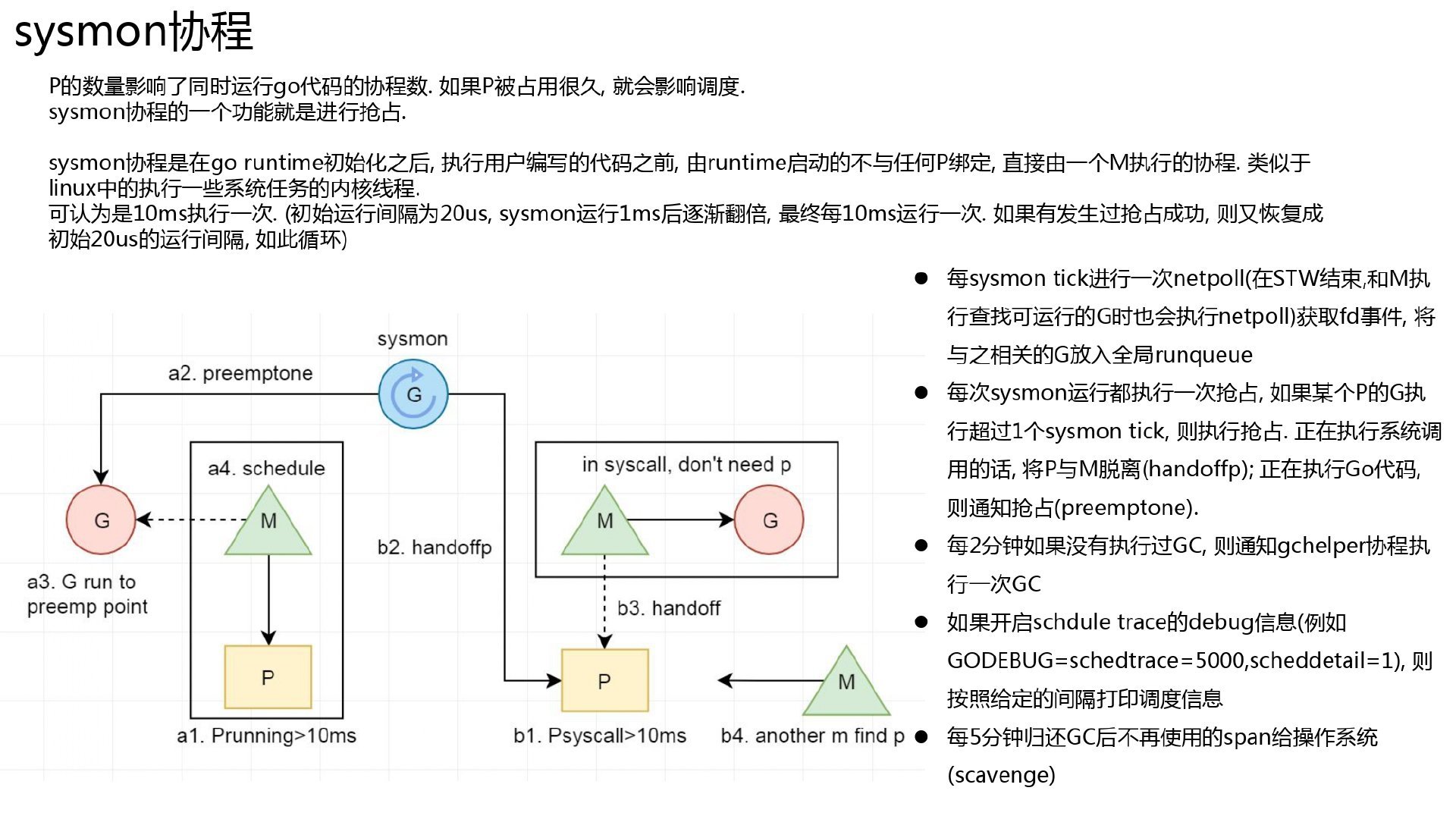 sysmon 协程
sysmon 协程
总结
- 调度器会记录当前是否处于轮训状态以及轮训的时间
- 记录有M相关的信息,如当前空闲的M,如果有多个的话,也会记录个数,记录的还有已用过数量,当前有多少个正在spinning,最大允许的M数量。同时也会记录其中持有锁的数量
- 记录有P相关的信息,如当前空闲P,空闲的数量。
- 持有当前系统 groutine 数量
- 有一个G的全局运行队列及其队列大小
- 通过gFree 记录有多少个空闲的G,可以被重复利用
- sudog缓存 和 deferpool
- 都有一个全局锁(lock)和 sysmon (sysmonlock)锁及其它锁(sugoglock)
- 可以控制是否禁用用户gorutine的调度行为,字段 disable(调用 schedEnableUser)
如果想学习Golang 的内存管理,则推荐先看这一篇 https://blog.haohtml.com/archives/29385
参考
- https://www.purewhite.io/2019/11/28/runtime-hacking-translate/
- https://www.zhihu.com/question/20862617/answer/27964865
- https://draveness.me/golang/docs/part3-runtime/ch07-memory/golang-garbage-collector/
- https://draveness.me/golang/docs/part3-runtime/ch06-concurrency/golang-goroutine/
- Go:g0,特殊的 Goroutine
- GPM 是什么
- Go 为什么这么“快”
- Golang和假共享(false sharing)
- CPU缓存体系对Go程序的影响
- 锁、内存屏障与缓存一致性
- 理解 Go 并发以及调度器亲和性
- https://www.zhihu.com/question/20862617
- https://blog.csdn.net/u010853261/article/details/84790392
- https://medium.com/a-journey-with-go/go-memory-management-and-allocation-a7396d430f44
- Go netpoller 网络模型之源码全面解析
- https://studygolang.com/articles/11627
- StackGuard的作用